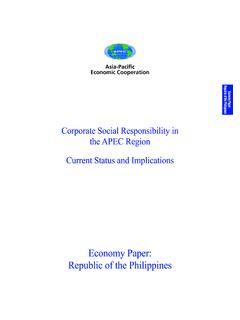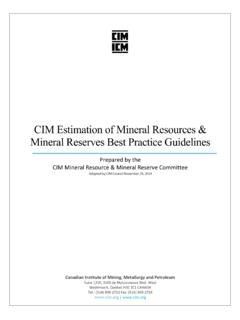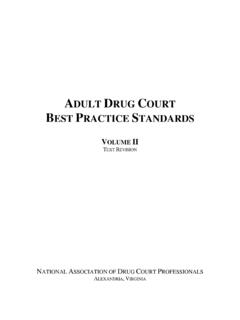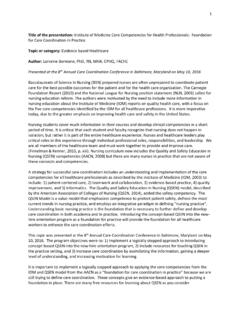Transcription of Agricultural Statistics Best Practice Methodology Handbook
1 Agricultural Statistics best Practice Methodology Handbook Implementation in APEC Member Economies APEC Agricultural and Technical Cooperation Working Group November 2013 APEC Project ATC 03/2011A Produced by For Asia Pacific Economic Cooperation Secretariat 35 Heng Mui Keng Terrace Singapore 119616 Tel: (65) 68919 600 Fax: (65) 68919 690 Email: Website: 2013 APEC Secretariat APEC# Agricultural Statistics best Practice Methodology Handbook Implementation in APEC Member Economies November 2013 Agricultural Statistics best Practice Methodology Handbook Implementation in APEC Member Economies DISCLAIMER The publication of this Handbook has been made possible by the support of the American people through the United States Agency for International Development (USAID).
2 Its contents are the sole responsibility of the author and do not necessarily reflect the views of USAID or the United States government. Contents Introduction 1 Part I. Design of Agricultural Census and Survey Implementation 3 1. Importance of the Census of Agriculture 5 2. Census of Agriculture: Methodological Considerations 13 3. Items for Agriculture Census 27 4. Community-level Data 33 5. Relationship of Agriculture Census to Population Census 39 6. Combining the Census of Agriculture with the Aquaculture Census 45 7. Collecting Data from Nonagricultural Producers Households 51 8. Program of Agricultural Surveys 55 9. Sampling Frames for Agricultural Censuses and Surveys 59 Part II.
3 Practical Statistical Methodology 67 10. Sampling Schemes for the Agricultural Survey Program 69 11. Determination of Sample Size 79 12. Estimation Procedures 83 13. Nonlinear Variance Estimation in Complex Surveys 91 14. Evaluation and Treatment of Survey Nonsampling Errors 95 Appendix. Concepts and Definitions of Agricultural Census Items Abbreviations BRR Balanced repeated replication CI Confidence interval CV Coefficient of variation Deff Design effect EA Enumeration area EPSEM Equal Probability Selection Methods FAO Food and Agriculture Organization of the United Nations FSUs First stage units GAP Good Agricultural practices GM Genetically modified ILO International Labour Organization IPM Integrated pest management IPPS Inclusion probability proportional to size ISCED International Standard Classification of Education ISCO International Standard Classification of Occupations ISIC International Standard
4 Industrial Classification of all Economic Activities MDG Millennium Development Goal MoS Measure of size MPPS Multivariate probability proportional to size NSE Nonsampling errors PPS WOR Varying probability sampling without replacement PPS WR Probability proportional to size sampling with replacement PPS Probability proportional to size PSU Primary sampling unit SA Subadministrative SRS Simple random sampling SRS Systematic sampling SSU Secondary sampling unit UN United Nations WCA World Census of Agriculture WOR Without replacement WR With replacement Acknowledgments This Handbook is based on two publications by the Food and Agriculture Organization (FAO) of the United Nations and reproduced with permission: A system of integrated Agricultural censuses and surveys, Volume 1, World Programme for the Census of Agriculture 2010.
5 FAO Statistical Development Series 11, Rome (2005). Reference Material on Sampling Methods. Technical note by Srivastava for the Regional Workshop on the Use of Sampling in Agricultural Surveys, Montevideo, Uruguay, June 2011 (2011). This report was prepared for the Asia-Pacific Economic Cooperation (APEC) organization as part of the APEC Technical Assistance and Training Facility (TATF) program. APEC TATF is managed by USAID, with funding and strategic direction provided by the State Department Bureau of East Asian and Pacific Affairs, Office of Economic Policy. The author of this document, Mr. Stephen Kellogg, would like to thank the FAO of the United Nations for authorizing the inclusion of its copyrighted material in this Handbook .
6 For further information, please contact Ms. Victoria Waite, Chief of Party, Introduction Reliable and timely Agricultural data provide producers and governments the information they need to make well-informed decisions in business and policy. Such data also improve food security by informing the development of strategies to combat poverty and measure the impact of interventions. Statistics compiled according to agreed on good practices , including practices for data collection, processing and dissemination, are crucial for economic and social development, providing an objective and replicable picture of the state of an economy, enabling comparisons, and setting baselines for measuring progress.
7 APEC s Agricultural Technical Cooperation Working Group has identified the lack of reliable Agricultural data, particularly from APEC developing economies, as a problem to be solved. In response, USAID s APEC Technical Assistance and Training Facility (TATF) program, in coordination with the Departments of State and Agriculture, organized the APEC Workshop to Assess and Improve Agricultural Data Collection and Dissemination by APEC Member Economies in Manila, Philippines, October 27-28, 2011. The workshop focused on the need to institute best practices in Agricultural data collection and use good data collection tools; on the challenges facing economies in collecting data; and on how reliable and timely Agricultural data are essential to trade, investment, and food security policymaking.
8 The workshop concluded that APEC member economies need to do more to improve the collection and dissemination of Agricultural data, including strengthening political commitment to improving statistical systems and integrating them into national statistical organizations. To begin a ddressing this need, APEC TATF conducted a baseline study of APEC economies practices in Agricultural statistical data collection in the second half of 2012. The study was based on international best practices laid out by the UN s Food and Agriculture Organization (FAO) in its series on the collection of Agricultural Statistics . best practices in Agricultural Statistics in APEC Member Economies compared each economy s practices to FAO guidance by analyzing websites relating to Agricultural Statistics and data and determining the degree to which each economy conformed with FAO guidance as described in the Global Strategy to Improve Agriculture and Rural Statistics1 and the Asia-Pacific Regional Action Plan to Improve Agricultural and Rural Statistics This analysis indicated where data collection systems and processes could be adjusted to improve quality, openness, and transparency.
9 1 Report Number 56719-GLB, World Bank, Washington, DC, 2011. 2 Improving Statistics for Food Security, Sustainable Agriculture and Rural Development, FAO Report Number APCAS/12/10, Rome, 2012. 2 Agricultural Statistics best Practice Methodology This Handbook provides guidelines for implementing best practices in Agricultural surveys as presented in the FAO s Global Strategy and for addressing many of the shortfalls revealed by best practices study. The Handbook draws heavily on FAO literature and the FAO s database of Agricultural Statistics , with emphasis on ways to achieve best practices in Agricultural Statistics and improve the coverage, consistency and quality of published data on food and agriculture in all APEC economies.
10 Part I draws heavily on the FAO s A system of integrated Agricultural censuses and Material in the appendix draws on Chapter 11 of the same publication to define best Practice core items discussed in the baseline study. Part II draws heavily on the FAO s Regional Workshop on the Use of Sampling in Agricultural Surveys - Reference Material on Sampling This reference material may be used by the statistical offices in each APEC economy in conjunction with their own plans to improve their Agricultural survey systems. 3 Volume 1 of the World Programme for the Census of Agriculture, FAO Statistical Development Series 11, Rome, 2010.





